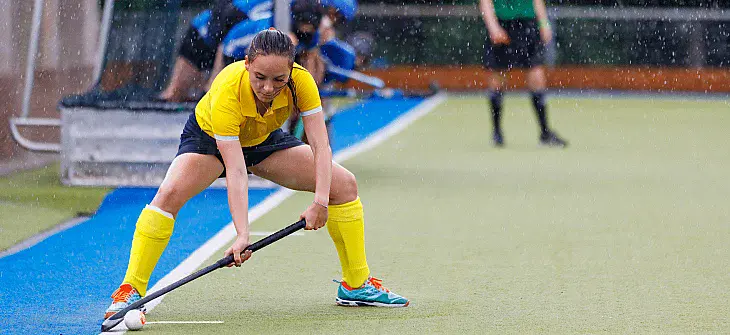It’s Just Weather – Tips for Training in Cold and Wet Conditions
During spring and summer, when the sun is shining and temperatures rise, it’s second nature to adjust training intensity and schedule regular hydration breaks.
However, training in autumn and winter presents a different set of challenges. Finding the right balance between activity and rest, choosing the right training clothing, and selecting appropriate training focuses and drills are all crucial. In colder months, planning training sessions with the weather in mind is essential to prevent illnesses among players.
Imagine a late November evening in Northern Germany:
🌡 2°C, moderate wind, and drizzling rain turning into occasional heavy showers.
Not the most inviting conditions, right?
But that’s no reason to cancel training! In fact, training in tough weather can be fun and even boost the immune system—as long as a few key aspects are considered.
Dressing Right for Cold and Wet Training Sessions
It may sound simple, but every coach has seen players—or their parents—with wildly different interpretations of "appropriate" training attire.
From the "tough guys" who show up in shorts and a t-shirt ("Coach, I’m fine! Wait… I’m freezing!") to the "wrapped-up warriors" whose layers of scarves, jackets, and hats make them barely recognizable ("Coach, make sure he keeps everything on!").
🔹 A good rule of thumb: If you feel slightly cold when stepping onto the pitch, you’re dressed just right for an active training session.
🔹 If you’re shivering, you need another layer (e.g., a thermal shirt or a training sweater).
🔹 If you’re already feeling warm, you may be overdressed and should consider wearing lighter clothing.
✔ Recommended training outfit for cold weather:
✅ Base Layer: Long thermal compression wear
✅ Mid Layer: Training jersey and/or sweatshirt
✅ Shorts (over compression tights)
✅ Optional Accessories:
✔ Light beanie
✔ Neck/face warmer
✔ Thin rain jacket
✔ Lightweight gloves
🔹 Layering is key! Several thin layers work better than one thick one, as they help regulate body temperature more effectively.
Choosing the Right Training Focus
Cold and wet weather is not ideal for learning new tactics or techniques that require long explanations and standing still.
Instead, the focus should be on:
✔ Reinforcing and refining existing skills.
✔ Ensuring constant movement to keep players warm.
✔ Training key technical areas (passing, dribbling, shooting, attacking sequences).
The key to successful training in poor weather is selecting the right training format.
Best Training Formats for Cold Weather
🔹 Keep players moving! Avoid drills that involve:
❌ Long waiting times at stations
❌ Too much standing around (players cool down quickly)
🔹 Game-based drills are ideal because they:
✔ Engage all players continuously
✔ Keep intensity high
✔ Feel like real gameplay, boosting motivation
If you must include drill-based exercises, ensure they:
✔ Keep players in constant motion
✔ Minimize pauses and waiting times
✔ Example drill options:
✅ Small-sided games with rule variations
✅ 5v5 in the penalty box with restrictions
✅ Zonal play drills
📢 If a drill isn’t working due to the weather, change it!
A good coach adapts to conditions and always has backup exercises that work in any situation.
Managing Training Intensity in Cold Weather
The goal is to keep players "under fire"—moving consistently to maintain body temperature.
💡 Key strategies:
✔ Keep warm-up short and dynamic
✔ Limit interruptions—avoid long breaks that cause players to cool down
✔ Shorten coaching explanations—focus on shadow coaching (giving instructions during play)
🔹 Active recovery instead of passive breaks
On hot summer days, a 5-minute rest in the shade makes sense.
In winter, replace passive breaks with light movement activities (e.g., rondos, ball control exercises).
✅ Hydration breaks are still essential!
❌ No standing in the wind for five minutes
✔ Keep breaks short (around two minutes)
Post-Training Recovery: Warming Up After Cooling Down
After training:
🚿 Take a warm shower immediately—no excuses!
👕 Change into dry, warm clothing
🧢 Wear a hat if necessary
⚠ Cold-weather training itself does not cause illness.
🚗 Driving home in wet clothes with damp hair does.
7 Key Tips for Training in Cold and Wet Conditions
1️⃣ Plan sessions in detail—manage activity, breaks, and rest times carefully.
2️⃣ Get players to "operating temperature" quickly and maintain it.
3️⃣ Minimize downtime—avoid long queues, unnecessary pauses, or prolonged explanations.
4️⃣ Keep explanations short and in motion—coaching should happen in action.
5️⃣ Use game-based training to maximize movement and engagement.
6️⃣ Maintain energy and motivation—keep the atmosphere positive!
7️⃣ Ensure post-training recovery—shower, change clothes, and stay warm.
✔ With the right planning, weather should never be an excuse to skip training.
✔ In fact, training in adverse conditions can even strengthen the immune system!
Weather Forecasts for Training – Built into VOOR!
Did you know that VOOR provides weather forecasts for training and matchdays?
🌤 No need to check a separate weather app—VOOR displays:
✔ Current conditions
✔ Expected weather for the next five days
✔ Likely pitch conditions
This feature helps coaches and players prepare for the right clothing and training strategies ahead of time.
Final Thoughts: Why This Matters
You might be wondering, why write about weather and training?
Because ideal conditions are rare. It’s either:
🔥 Too hot
❄ Too cold
🌧 Too wet
💨 Too windy
☀ Too sunny
And all of this affects training participation and planning.
Even the best training program fails if the weather isn’t considered.
Smart planning ensures players stay engaged, develop, and train effectively—no matter the conditions.

